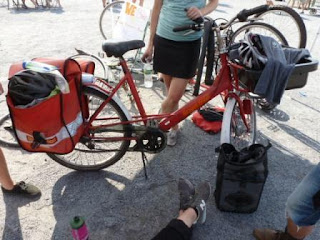In my previous life--many years ago--I saw an Atala bicycle for the first time. Then, it was as exotic to me as African masks and Japanese prints must have been to French artists in the middle of the 19th Century.
Even next to other racing bikes I'd seen, it seemed almost other-worldly. For one thing, it was probably the first bike I saw that was equipped with Campagnolo components--although I had no idea of what they were, let alone why they were so revered. Hey, I didn't even know that the frame was made of Columbus tubing, which was the only equal to Reynolds 531.
One thing I knew for certain was that the bike was pretty (even prettier than the one in the above photo): painted in a kind of coral color with white bands and chromed lugs and dropouts, if I recall correctly. In fact, I probably thought it was the prettiest bike I'd seen up to that time.
As I came to know about and ride other bikes, I was less impressed with Atalas. Whatever awe I had for them was all but destroyed after I worked on a few in bike shops: Other bikes, from Italy as well as other countries, had much better workmanship.
But seeing that Atala important for me for one other reason. Atala was probably the first bike brand I encountered for the first time through its top racing model. I knew of Royce-Union, Schwinn, Raleigh and a few other manufacturers through their three-speeds, baloon-tired bombers or their kids' "Chopper" or "Sting-Ray"-style bikes, and would later encounter their road bikes. I first learned of Peugeot, Gitane and few other French makers through their lower-level ten-speed bikes, which seemed to appear like toadstools after a rainstorm during the early years of the BIke Boom. A couple of years later, I would encounter Japanese bike makers like Fuji, Nishiki and Miyata in a similar fashion.
It wasn't until years later, when I went to Italy for the first time, that I saw an Atala city bike. Back then, such bikes were all but unavailable in the US: Bike shops would stock a model from, say, Peugeot or Kabuki; it wouldn't sell and everyone would conclude there was no market for such bikes.
Over the past two or three years, I have been seeing more city bikes from European and Japanese companies that, for decades, have been making them for people in their own countries. One of those bikes is the Atala I saw tonight, parked just a few doors away from the apartment of a friend I was meeting.
I'll bet that whoever rides that bike has never seen that Atala racing bike I encountered a long time ago, in another life.










